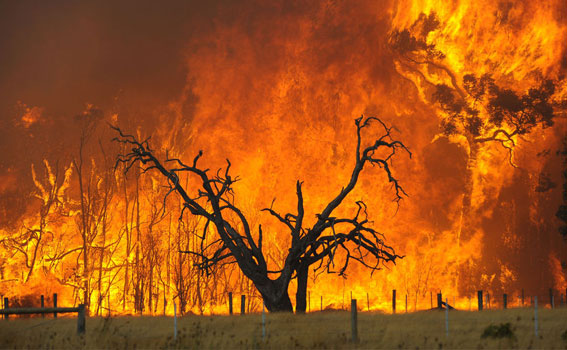Responses of vegetation to environmental change
In this module we will examine the ways in which terrestrial plants respond to environmental change. This module builds on knowledge gained in Module 1 The Physical Environment and mirrors themes explored in Module 2 Responses of Terrestrial Animals to Environmental Change, namely how organisms respond to natural patters of environmental change. If we understand these responses, we have some chance of understanding likely changes to ecosystem function we might expect with climate change or land use change.
As you saw in Module 2, animals have a range of behaviours as well as physiology and morphology to cope with environmental change and stress, i.e. they can move within a range, if conditions are unfavourable. Plants are static and must be able cope with the full range of environmental conditions if they are to grow to maturity and reproduce. They also feature a wide range of morphological and physiological adaptations to enable them to exist at a particular combination of climate type, disturbance regime and soil type.
In Topic 1 of this module we will explore how plants respond to the environmental factors such as temperature, light, rainfall and moisture, humidity. How do these factors influence plant physiology, i.e. growth via photosynthesis, water use, nutrient uptake and reproduction? How does a single leaf respond, through to a whole plant canopy or ecosystem ? We need to understand how plant systems to respond to environmental signals and environmental change. This knowledge can be used in mathematical models that can be used to predict how vegetation distribution, biodiversity and productivity may be impacted if we change our environment.
In Topic 2 we explore an agent of change – disturbance processes. Disturbance can be considered as episodic and extreme events, e.g. climatic events or disease outbreaks, that severely impact plant and animal populations. These events can occur quite randomly or with a degree of repeatability. We will look at the nature of disturbance events in this module.
Climate change, Topic 3 is likely to be responsible for changing environmental / climate variables as covered in Topic 1 as well as influencing the frequency and severity of disturbance events as described in Topic 2. We will considered how plant systems may respond to climate change in this Topic.
Some knowledge is assumed – text books such as The Biology of Plants by Raven et al. will provide background. Key chapters can be found in the unit Reading List along with readings as detailed below.

Readings
- Franklin J., Serra-Diaz J.M., Syphard, A.D., Regan, H.M. (2016) Global change and terrestrial plant community dynamics. Proceedings of the National Academy of Sciences of the United States 113: 3725–3734
- Lambers H., Chapin F.S., Pons T.L. (2008) 'Assumptions and Approaches', in Plant Physiological Ecology, 2nd Edition, Spring, Berlin
- Eamus D. (1998) Ecophysiological traits of deciduous and evergreen woody species in the seasonally dry tropics. Trends in Ecology & Evolution 14: 11-16
- Prior L.D., Bowman D.M.J.S. Eamus D. (2004) Seasonal differences in leaf attributes in Australian tropical tree species: family and habitat comparisons. Functional Ecology 18: 707–718
- Beringer J., Hutley L.B., Tapper N.J., Cernusak L.A. (2007) Savanna fires and their impact on net ecosystem productivity in north Australia. Global Change Biology 13: 990–1004.
- Lugo A.E. (2008) Visible and invisible effects of hurricanes on forest ecosystems: an international review Austral Ecology 33: 368–398
- Frank et al (2015) Effects of climate extremes on the terrestrial carbon cycle: Concepts, processes and potential future impacts. Global Change Biology, 21(8), 2861–2880. https://doi.org/10.1111/gcb.12916
- CSIRO Division, (2016) Change in Australia - Northern Territory. https://www.climatechangeinaustralia.gov.au/en/projections-tools/regional-climate-change-explorer/sub-clusters/?current=MNWC&tooltip=true&popup=true
- CSIRO Division, (2016) Change in Australia - Climate Campus.
https://climatechangeinaustralia.gov.au/en/decision-tree/climate-change-science//